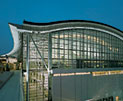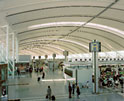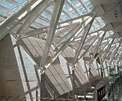Flights of Fancy in Long-Span Design
An adjacent structural module would similarly be erected on a central column approximately 60 feet from the first. The space defined by the girders of the two adjacent modules would also be filled in with secondary roof members and skylight framing, thereby creating yet another bay of the same dimension.
The architects wanted the horizontality of the terminal's linear scheme to visually dominate the design. To accomplish this, they had to carefully consider the architectural and structural relationships between roof and elevation. The practitioners, for example, extended the roof significantly beyond the glazed facade. Moreover, they introduced what came to be called "cable kipper trusses" to avoid heavy vertical support members within the glazing system. Installed every 30 feet, these elegant vertical components support horizontal mullions, which in turn carry the high-performance glass.
The cable trusses are held in tension by the steel roof above and the concrete floor below. In essence, explains Les Postawa, technical director at SKM Anthony Hunts, "The roof holds up the wall." During assembly of the roof, the contractor used provisional jacks to induce a temporary tensile load. Once the kipper trusses were installed, the jacks were gradually released and removed.
Lester B. Pearson International Airport
Toronto's Pearson Airport dates back to the 1950s, when the first of what were to be three round terminals was constructed. The circular parti-in which passengers drove in at the bottom, parked at the top, and accessed planes along the circumference-became outmoded as soon as wide-body aircraft were introduced, so the other two cylindrical terminals were never built. By the 1960s, a cargo facility was remodeled to serve as a second terminal, although offering little in the way of amenities. In the 1980s, yet another terminal was constructed.
By the mid-1990s, the Greater Toronto Airports Authority (GTAA) subsequently engaged NAPA, an airport planning firm in Toronto, to develop a master plan. Completed in 1997, it proposed that, over time, the first two terminals should be demolished and a new, continuous facility constructed-all while the airport remained operational.
To undertake this mammoth endeavor, GTAA engaged Airport Architects Canada, which is a joint venture formed by three firms: Skidmore, Owings & Merrill International (SOM), Adamson Associates Architects, and Moshe Safdie Associates Architects.
Laura Ettelman, AIA, an associate partner at SOM and project manager for Airport Architects Canada, explains that the effort is being implemented in three stages: The first stage of the new terminal was completed in 2004; the second stage is scheduled to open in 2007; and the third stage is expected to be finished by 2012.
The New York office of Arup led the schematic design and design-development phases of the structural design for stage 1, which includes the central processor-the main portion of the terminal that contains functions such as ticketing, baggage claim, and security. The Toronto office of Halcrow Yolles is the engineer of record for the entire terminal building, in addition to undertaking schematic design and design development for stage 2.












